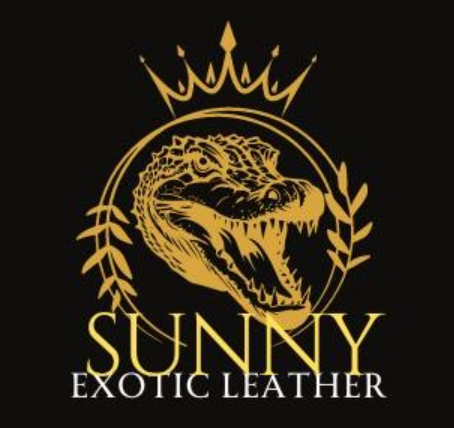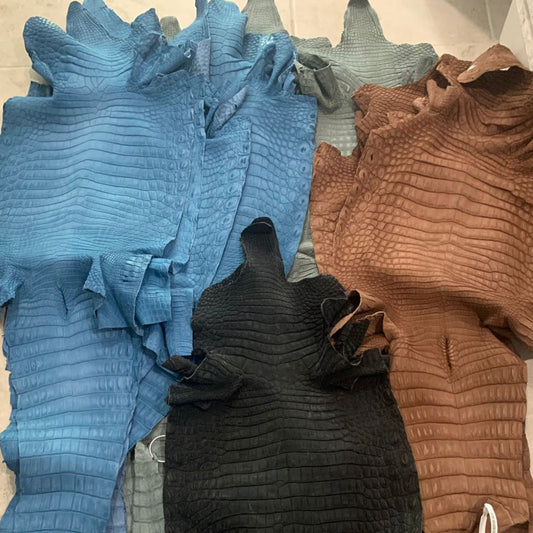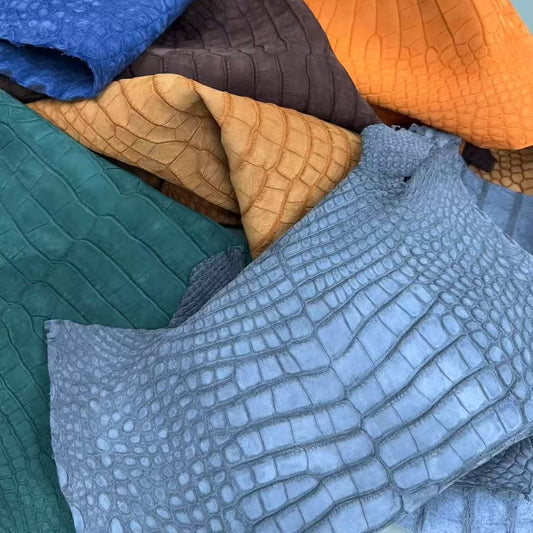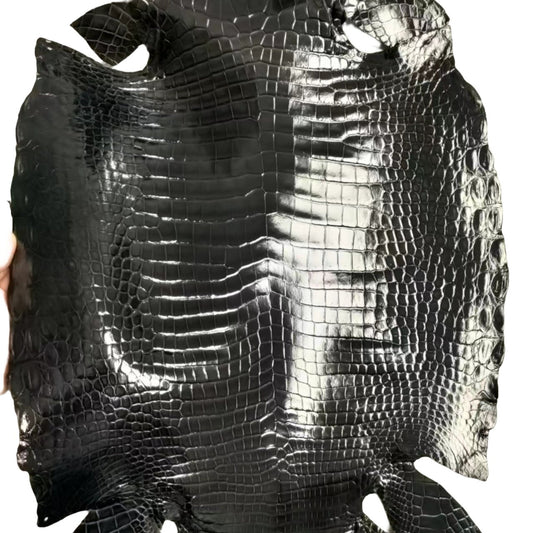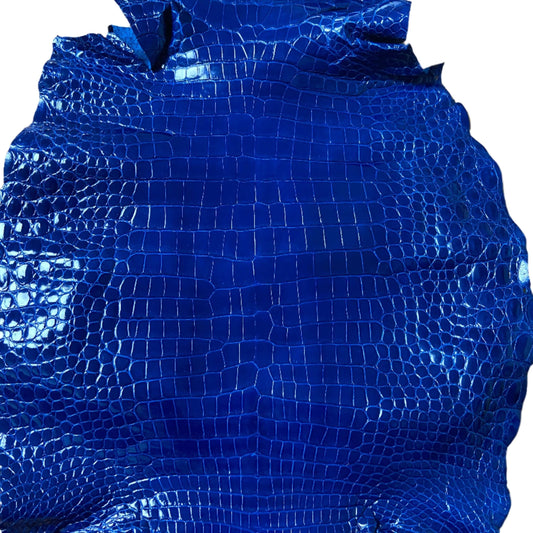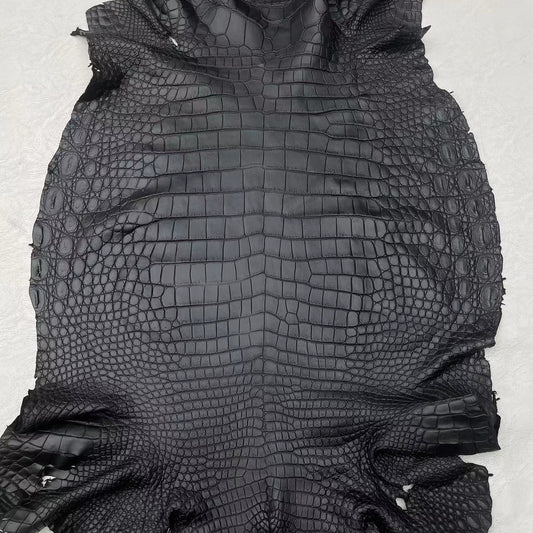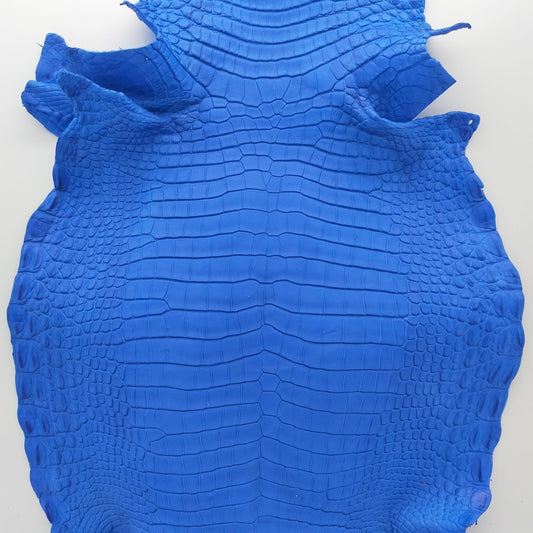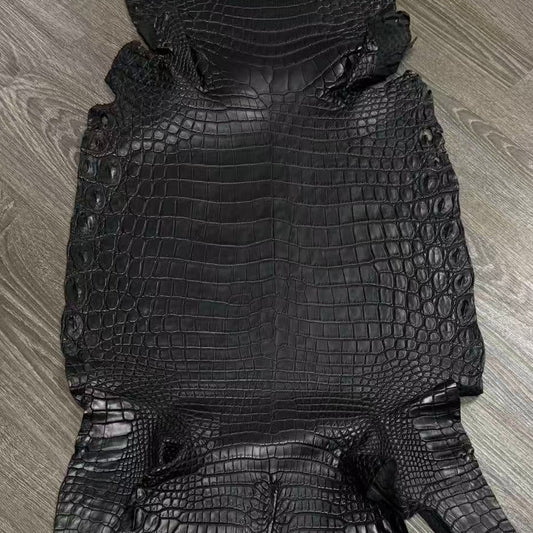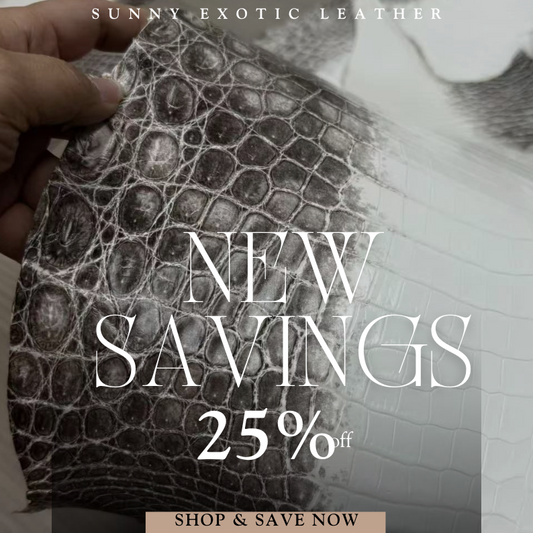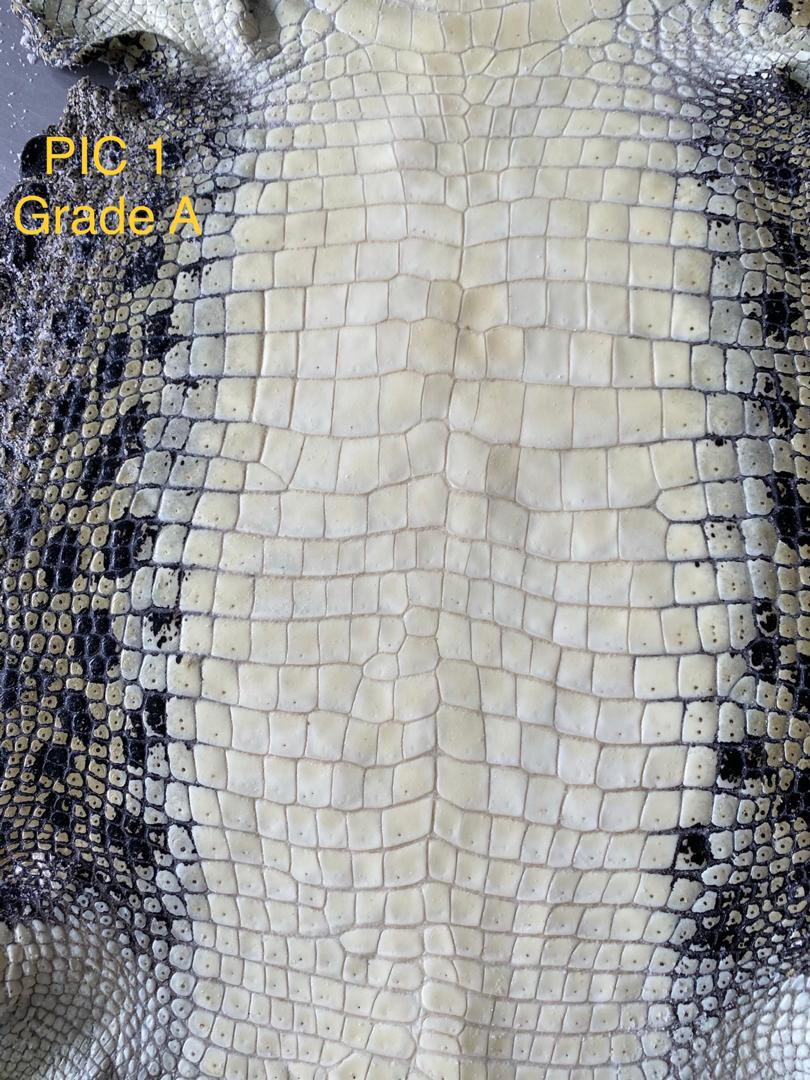
Todo lo que necesitas saber sobre el cuero de cocodrilo exótico
Compartir
Acerca del cuero de cocodrilo
El cuero de cocodrilo, también conocido como piel, cuero o croc, es la piel curtida y procesada de una de las diversas especies de cocodrilo de todo el mundo. Se considera un cuero exótico debido a su relativa rareza y al nivel de artesanía requerido para producir una piel de cocodrilo terminada para usos de producción tales como bolsos, ropa, muebles y tapicería.
La siguiente guía tiene como objetivo instruir a aquellos interesados y/o ya involucrados en la producción de bienes con cueros de lujo, proporcionando datos e información sobre los cocodrilos, sus pieles y aplicaciones para bolsos, prendas de vestir, muebles, tapicería y otros artículos.
Al final de esta guía, debería tener un conocimiento básico de la especie, sus aspectos legales, cómo trabajar con cuero de cocodrilo, así como sus especificaciones y medidas.
Piel de cocodrilo: aspectos básicos
¿Cuál es el atractivo de la piel de cocodrilo?
El cuero de cocodrilo es considerado uno de los más valiosos y se encuentra en las líneas de moda de las marcas más importantes, como Vuitton, Gucci, Versace y Burberry. Si bien el cuero de cocodrilo puede estar “de moda” o “fuera de moda” en una temporada en particular, los productos en sí rara vez pierden su valor debido a su cuero atemporal y su artesanía.
Como ocurre con todos los bienes de lujo, la escasez del cuero desempeña un papel importante a la hora de determinar su valor. Por “escasez” no se entiende solo la oferta limitada, sino también la disponibilidad de granjas o cazadores, instalaciones de curtido con las herramientas y los conocimientos adecuados para producir una piel de cocodrilo acabada y las limitaciones que impone el tamaño de la piel. Y, a pesar de ello, el precio de las pieles crece exponencialmente con el tamaño de la piel.
Los cocodrilos se crían en granjas o se capturan en estado salvaje, y ambos métodos tienen factores que influyen en su escasez:
En el caso de los cocodrilos de granja, cuanto más grandes son, más alimentos necesitan y más riesgos conlleva su cuidado. A medida que un cocodrilo alcanza la madurez, puede llegar a consumir más del doble de comida que el año anterior. Los cocodrilos son depredadores por naturaleza y, además, se vuelven cada vez más agresivos a medida que envejecen. A menudo, los cocodrilos más grandes deben estar alojados en sus propios corrales y habitaciones. Esta es la proporción:
20 – 24 cm (1,0 año en la granja)
25-29cm (1,5 años en la granja)
30-34 cm (2,0 años en la granja)
35-39cm (2,5 años en la granja)
40-44cm (3,0 años en la granja)
45 cm más arriba (3,5 años en la granja)
Los cocodrilos capturados en estado salvaje tienen un problema recíproco único: si bien la alimentación y el cuidado no son relevantes, corren un mayor riesgo en su entorno natural de sufrir traumas físicos que les produzcan cicatrices e inconsistencias. Un cocodrilo de tres años o más sin cicatrices en la piel es, en efecto, un hallazgo poco frecuente.
Por último, otro factor que influye en el precio de las pieles de mayor tamaño es la mayor demanda de su utilización. Por ejemplo, un diseño para un bolso de 16″ requerirá una piel de 40-44 cm. Una piel de este tamaño procederá de un cocodrilo que haya sido criado o que se haya encontrado que tiene al menos 3 años.
¿De donde viene?
Hay tres especies de cocodrilos que se comercializan en todo el país, cada una con sus propios beneficios:
- Cocodrilo de agua dulce ( Crocodylus novaeguineae ): los cocodrilos de agua dulce de Nueva Guinea se encuentran entre los cueros más buscados y de mayor calidad que existen. Por lo general, se les da un acabado mate o esmaltado y la naturaleza de las pieles permite que se las pueda cortar hasta que queden delgadas para que sean flexibles para la confección de prendas.
- Cocodrilo de agua salada ( Crocodylus porosus ): el cocodrilo de agua salada de Australia es un producto raro y se encuentra entre los cocodrilos más grandes de todos. El tamaño extra grande de su piel lo hace ideal para usos en los que se desea una piel más grande, como paneles anchos para bolsos o maletines, revestimientos de paredes y tapicería.
- Cocodrilo del Nilo ( Crocodylus niloticus ): las pieles de cocodrilo del Nilo suelen ser las preferidas para la producción de cuero debido a su tamaño, resistencia y disponibilidad en toda África. En su tamaño completo, el cocodrilo del Nilo mide aproximadamente entre 3,5 y 5 m de largo y produce una piel terminada de entre 28 y 35 cm de ancho.
- * Cocodrilo caimán ( crocodilus fuscus ): el cocodrilo caimán a menudo se vende como "cocodrilo genuino". Si bien esto es cierto hasta cierto punto, y no subestimaremos el atractivo y la demanda de productos de caimán, en el comercio de cuero exótico, es importante distinguir al caimán de otras especies de cocodrilos, ya que no posee la misma calidad o valor en artículos de lujo en relación con los demás. Los caimanes se consideran una opción económica debido a su ubicuidad y su tamaño y pieles más pequeños. Para usos de producción, son pieles más pequeñas con menos flexibilidad que sus primos de agua dulce, agua salada o Nilo, lo que limita su uso en la elaboración de artículos de cuero.
Aplicaciones y usos del cuero de cocodrilo
Las pieles de cocodrilo se utilizan en muchas aplicaciones, como bolsos de lujo, cinturones, billeteras, ropa, tapicería para automóviles y muebles que brindan a los diseños una apariencia personalizada y lujosa con resistencia y durabilidad. Las pieles de cocodrilo se pueden curtir en muchas texturas y colores personalizados, lo que deja al diseñador muchas posibilidades para agregar lujo a artículos nuevos o existentes.
Cuero de cocodrilo: clasificación y medidas
Las pieles de cocodrilo vienen en dos cortes distinguibles para la artesanía del cuero: un corte posterior, que es un corte más áspero y texturizado popular en recortes y aplicaciones donde se desea la textura escamosa, y un corte del vientre, que es un corte más suave y flexible que es popular en tapicería y bolsos.
Cómo se miden las pieles de cocodrilo
Para determinar el valor total de una piel, las pieles de cocodrilo se miden por el ancho de la parte más grande del cuerpo, en el segundo hueso de cada lado. Al comprar una piel, debe tener en cuenta que las medidas corresponden a la piel en general y no al ancho del patrón, por lo que debe comprar una piel que sea lo suficientemente grande para el uso que le va a dar.

Cómo se clasifican las pieles de cocodrilo
La clasificación de la piel de cocodrilo es importante para determinar el precio de una piel terminada. Una piel de primera calidad, o piel de “Grado A”, está reservada para las mejores pieles. Estas pieles estarán libres de defectos en la mayor parte, si no en toda, la piel.
Las pieles de “grado B” presentan inconsistencias y defectos, pero generalmente hay una gran parte de la piel que aún tiene materiales utilizables para aplicaciones más pequeñas, como adornos, billeteras, sombreros y más. Algunos defectos que pueden afectar la clasificación de A a B incluyen:
1) Tejido cicatricial
2) Agujeros de cualquier tipo, incluidos los causados por errores en el proceso de curtido.
3) Decoloración o tinte desigual.
Piel de cocodrilo: aspectos legales
Las cuestiones legales para importar y exportar piel de cocodrilo difieren en todo el mundo. En Estados Unidos, si bien los cocodrilos no son una especie autóctona de la región como los caimanes, la piel de cocodrilo se puede importar y exportar legalmente siempre que cumpla con las normas de la CITES. Sin embargo, existen algunas restricciones comerciales. Por ejemplo, la importación, posesión y venta de cocodrilos siameses de agua dulce de Tailandia, Vietnam o Camboya está estrictamente prohibida en Estados Unidos, independientemente de que se presenten los documentos correspondientes de la CITES. Lamentablemente, a pesar de este hecho, hay vendedores en estos países que aún intentan enviar y vender esta especie a estadounidenses desinformados que cometen involuntariamente actos delictivos al intentar importar estas pieles.
Conozca siempre el origen de su producto. Si se encuentra en los Estados Unidos, debe asegurarse de que el cuero que recibe sea legal y tenga la autorización de CITES y de Pesca y Vida Silvestre.
Acerca de los cocodrilos
Cocodrilo Puede significar vagamente un número de especies dentro de la familia. Crocodylidae . Se encuentran comúnmente en la mayoría de las regiones del mundo, viviendo en ríos y humedales. Son poderosos carnívoros que suelen alimentarse de otros animales como peces, mamíferos y otros reptiles. Los cocodrilos son una de las especies vivas más antiguas de la Tierra, con más de 200 millones de años.
Sus poderosas colas les ayudan a moverse rápidamente por el agua y, aunque pueden parecer lentos y perezosos cuando están quietos, son rápidos para atacar a sus presas. Los cocodrilos tienen las mandíbulas más poderosas de todos los animales y dientes afilados para atrapar y comer; un comportamiento común de un cocodrilo es "dar vueltas" o "rodar" en el agua después de sujetarse para arrancar trozos de carne de sus presas (a menudo) desprevenidas. Por instinto, son uno de los depredadores naturales más fuertes y poderosos: un verdadero rey del río que atacará y se comerá a casi cualquier criatura que se cruce en su camino.

